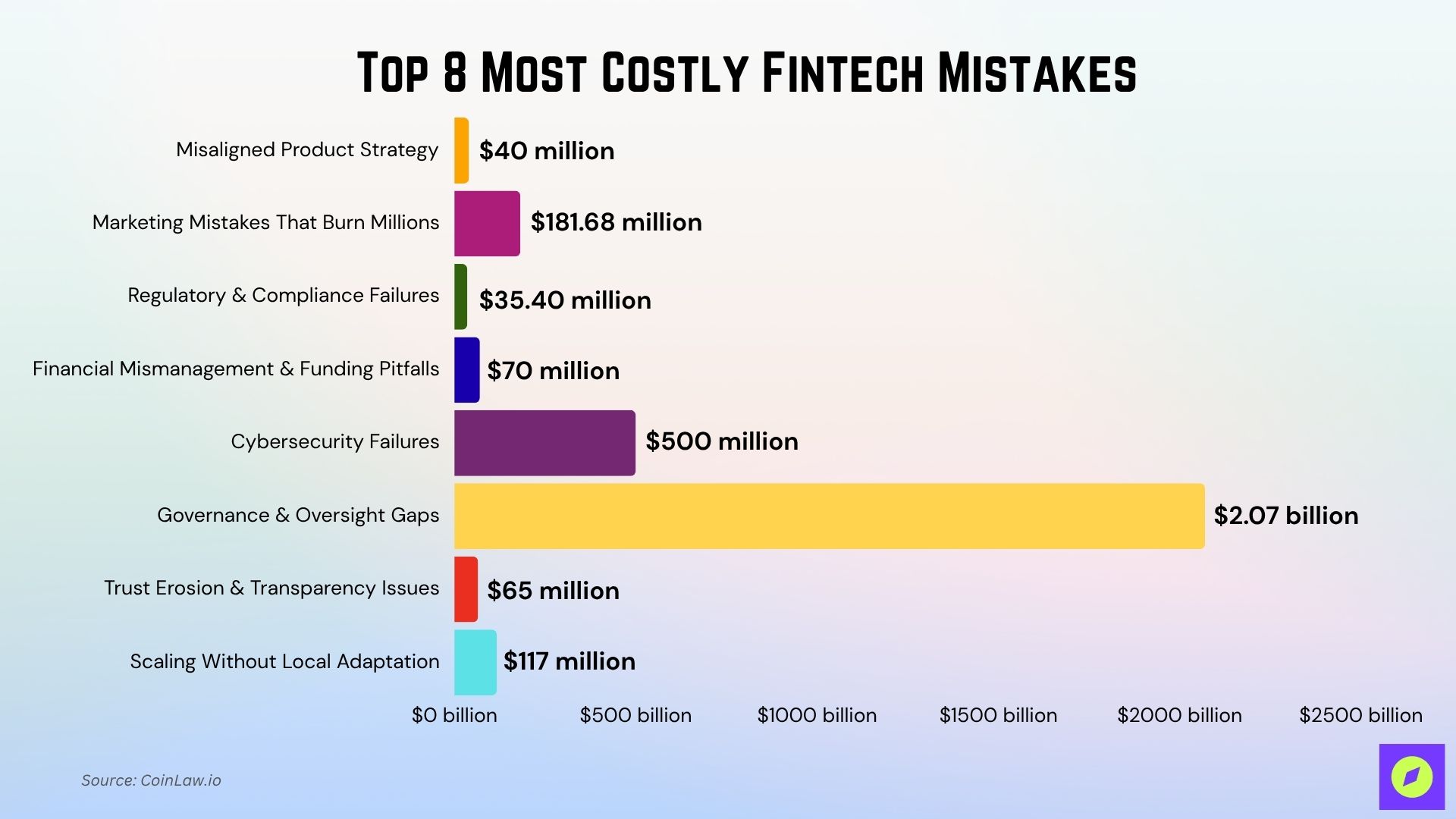Fintech has revolutionized global finance, introducing faster payments, innovative lending models, and borderless financial services. But behind the success stories lie high‑profile failures, some costing hundreds of millions, or even billions, of dollars. From compliance breaches to governance collapses, these mistakes cripple promising ventures and erode investor trust. In an industry where innovation moves faster than regulation, understanding what not to do is just as critical as spotting the next big opportunity.
Key Takeaways
- 1Fintech failures have cost billions due to poor market fit, compliance lapses, governance gaps, and rushed expansion.
- 2Trust, transparency, and customer‑centric design are as important as technology and funding.
- 3Real‑world case studies show how poor oversight, weak marketing, or inadequate risk planning can devastate even well‑funded startups.
- 4Mitigation starts with disciplined strategy, robust compliance, and a culture of adaptability.
Top 8 Most Costly Fintech Mistakes
These eight mistakes have collectively cost fintech companies billions in losses, fines, and missed opportunities. From poor market alignment to scaling failures, they show why disciplined planning and governance are essential for survival.
| Mistake | Why It’s Costly | Real Example | Loss / Fine Amount |
| Misaligned Product Strategy | Leads to poor adoption, wasted resources, and revenue loss. | Retail financial app with poor market fit. | Over $40 million |
| Marketing Mistakes That Burn Millions | Ineffective campaigns drain budgets and slow growth. | Monzo’s poorly optimized marketing spend. | Over £130M (~$181.68M) |
| Regulatory & Compliance Failures | Triggers heavy fines and can suspend operations. | Starling Bank fined for AML failures. | £28.96M (~$35.4M) |
| Financial Mismanagement & Funding Pitfalls | High burn rate leads to insolvency and collapse. | Southeast Asian lending startup is overspending. | $70 million |
| Cybersecurity Failures | Breaches cause financial loss, legal issues, and trust erosion. | Coincheck crypto exchange hack. | Over $500 million |
| Governance & Oversight Gaps | Poor oversight leads to fraud, collapse, and regulatory failure. | Wirecard accounting scandal. | €1.9 billion (~$2.07 billion) |
| Trust Erosion & Transparency Issues | Loss of user trust damages brand equity and retention. | Robinhood SEC fine for misleading customers. | $65 million |
| Scaling Without Local Adaptation | Poor market fit in new regions wastes investment. | BBVA’s Simple Bank acquisition. | $117 million |
1. Misaligned Product Strategy
Many fintech startups launch without validating strong product‑market fit, chasing growth over genuine customer needs. This often leads to wasted resources, weak adoption, and early collapse.
- Real Example: A retail financial app reportedly burned through over $40 million before folding due to poor market differentiation and demand validation.
- Why It’s Costly: Missed market alignment causes high churn, low revenue, and millions lost in unnecessary development and marketing.
- How to Avoid It: Conduct thorough market research, run pilot programs, and integrate real user feedback before scaling.
2. Marketing Mistakes That Burn Millions
A brilliant fintech product can still fail without an effective, sustainable marketing strategy. Over‑reliance on paid acquisition and weak brand positioning can drain capital without building loyalty.
- Real Example: In 2021, Monzo reported a net loss of £130 million (~$181.68 million), partly due to costly, poorly optimized marketing campaigns.
- Why It’s Costly: Ineffective campaigns waste millions, delay profitability, and leave brands invisible in competitive markets.
- How to Avoid It: Craft a trust‑driven brand story, balance paid and organic strategies, and leverage referral programs for growth.
3. Regulatory and Compliance Failures
Ignoring licensing rules, AML/KYC requirements, or local regulations can cripple a fintech operation overnight. Compliance gaps often trigger fines, investor flight, and market exclusion.
- Real Example: In October 2024, Starling Bank was fined £28.96 million (~$35.4 million) for failings in financial‑crime controls and sanction screening.
- Why It’s Costly: Non‑compliance leads to heavy penalties, loss of credibility, and potential suspension of operations.
- How to Avoid It: Hire compliance experts early, implement strong AML/KYC systems, and conduct ongoing regulatory audits.
4. Financial Mismanagement and Funding Pitfalls
Spending aggressively without a sustainable revenue model can sink even well‑funded fintechs. Undisciplined budgeting and over‑reliance on venture capital amplify collapse risks.
- Real Example: A Southeast Asian lending startup raised $70 million but folded within two years due to overspending and neglecting risk controls.
- Why It’s Costly: High burn rates deplete funding quickly, force down‑rounds, and can cause total shutdowns.
- How to Avoid It: Maintain budget discipline, diversify funding sources, and invest in core risk infrastructure before expansion.
5. Cybersecurity Failures
Customer trust is the lifeblood of fintech, and breaches can destroy it overnight. Underinvestment in security systems leaves platforms exposed to devastating attacks.
- Real Example: In 2018, Coincheck lost over $500 million in one of the largest crypto hacks in history.
- Why It’s Costly: Breaches cause massive financial loss, regulatory scrutiny, and irreversible damage to brand trust.
- How to Avoid It: Invest in advanced security tools, run regular audits, and train staff in cybersecurity best practices.
6. Governance and Oversight Gaps
Even with strong products and funding, weak governance can sink a fintech. Poor oversight enables unchecked risks, internal fraud, and strategic misalignment.
- Real Example: In 2020, Wirecard collapsed after revealing that €1.9 billion (~$2.07 billion) in assets didn’t exist.
- Why It’s Costly: Governance failures lead to fraud, loss of investor trust, and complete corporate collapse.
- How to Avoid It: Implement clear governance structures, conduct independent audits, and maintain strict internal controls.
7. Trust Erosion and Transparency Issues
Hidden fees, unclear terms, and poor customer service can erode trust quickly in fintech. Once trust is lost, winning it back is extremely difficult.
- Real Example: In 2020, Robinhood was fined $65 million by the SEC for misleading customers about payment‑for‑order‑flow revenues.
- Why It’s Costly: Loss of trust results in churn, reputational harm, and increased regulatory scrutiny.
- How to Avoid It: Adopt transparent pricing, communicate openly, and resolve customer complaints promptly.
8. Scaling Without Local Adaptation
Expanding into new markets without adapting to local regulations, culture, or consumer behavior is a costly misstep. What works in one country may fail entirely in another.
- Real Example: BBVA acquired Simple for $117 million but shut it down after failing to adapt it to broader market needs.
- Why It’s Costly: Mismatched offerings waste investment, damage brand credibility, and stall growth.
- How to Avoid It: Conduct localized market research, customize offerings, and partner with regional financial institutions.

Best Practices to Avoid Costly Mistakes
Avoiding multi‑million‑dollar fintech failures requires more than just innovation; it demands disciplined planning, risk management, and continuous market alignment. By embedding these practices early, fintech companies can safeguard growth, protect user trust, and stay ahead in a fast‑evolving industry.
- Validate Product‑Market Fit Early – Conduct detailed market research and launch beta programs to refine offerings before full rollout.
- Build a Sustainable Marketing Strategy – Balance paid and organic channels while investing in authentic brand storytelling.
- Prioritize Compliance from Day One – Hire seasoned compliance experts and maintain robust AML/KYC systems with regular audits.
- Practice Disciplined Financial Management – Monitor burn rate, maintain accurate cash flow forecasts, and diversify funding sources.
- Strengthen Cybersecurity Infrastructure – Invest in fraud detection, continuous monitoring, and regular security training for staff.
- Enhance Governance and Oversight – Create clear governance frameworks and conduct independent audits for transparency.
- Be Transparent to Build Trust – Clearly communicate fees, terms, and respond promptly to customer issues.
- Adapt to Local Markets When Scaling – Localize product features and partner with regional institutions for smoother expansion.
Conclusion
Fintech’s rapid growth brings both unparalleled opportunity and significant risk. The industry’s most costly mistakes, ranging from product misalignment to governance failures, prove that innovation without discipline can lead to massive losses. By embedding best practices in market validation, compliance, governance, trust‑building, and local adaptation, fintech leaders can safeguard against billion‑dollar pitfalls. In a sector where the margin for error is razor‑thin, those who plan strategically, execute responsibly, and adapt quickly will be best positioned to thrive in the evolving financial landscape.

























































